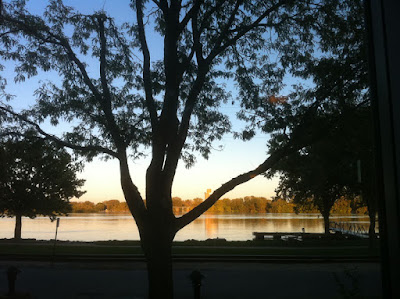I headed to
Ottawa National Wildlife Refuge because I was wanting to visit as many National Wildlife Refuges as I could find along our route. As we left Detroit, I knew I wanted to revisit Bombay Hook in Delaware, and I knew I wanted to visit Chincoteague in Virginia. Since we didn't have a set itinerary for this trip, we could stop and explore new places. But because we didn't have a planned itinerary, I hadn't done much research about places we would be visiting.
We got to Ottawa NWR later in the afternoon. I was excited because the following day was the one day of the month that the auto route was open and I was looking forward to viewing parts of the refuge that are normally closed to the public.
When we arrived, I learned quickly that Ottawa is a refuge where you hike to get to the best parts. There are also two adjoining state wildlife management areas. I stopped and chatted with other people walking the refuge. I was asked, "How does this compare with other refuges you have visited?" I must confess I didn't have a good answer, because I had just gotten there and because I hadn't done the research to know what was the best "season" to visit. One of my favorite wildlife refuges is Bosque del Apache. If you go in the winter, it is an incredible places with thousands of geese, ducks, sandhill cranes, and many wintering raptors. In the summer, the Bosque is quiet. On my first fall afternoon visit, Ottawa seemed quiet - lovely, but quiet. I got to see a bald eagle soar by a couple of times, the ducks were apparently on a pond a farther walk than I had time for. My bird list was short, because my walk was short: white crowned sparrow, blue jay, golden-crowned kinglet, ruby-crowned kinglet, Canada geese, Great blue heron, great egret, American robin, and red wing blackbird.
We drove over to
Magee Marsh Wildlife Area right at twilight and I found the marsh boardwalk. That would be my dawn destination. Magee Marsh is owned and managed by the state of Ohio.
We got up early enough that I was on the boardwalk as the sun was coming up. I was traveling light - my iPhone, my binoculars, and my Sibleys.
As I walked the boardwalk, I could hear skittish waterfowl relocating. I was pleased to see and identify a swamp sparrow in the brushy area by the waterline near the boardwalk. A downy woodpecker was working his way up and down a nearby tree. The redwing blackbirds were on the reeds across the water. I saw another bird working its way up the tree - after looking in Sibleys - a brown creeper. I finally caught a glimpse of the waterfowl I was spooking - a winter plumage wood duck.
The wonderful thing about this boardwalk is that there are plenty of benches - places where you can sit, wait for the birds to come check you out and where you can savor your surroundings. I saw another set of birds that I don't usually see - so had to look them up - thrushes, both Swainson and Hermit (I'm pretty sure I saw both species.) As I scanned the boardwalk in front of me, a house wren appeared to check out who was coming. In the one of the water pools was a great egret and I could hear Canada geese in the distance. Another bird appeared along the boardwalk, a wren for sure with that upright tail, but oh so small. When checking Sibleys - a winter wren - a life bird for me. And it stayed around long enough for me to get a good look see. Another bird appeared requiring another search in Sibleys - a juvenile yellow bellied sapsucker. As I finished my walk, I saw a ruby crowned kinglet and a Carolina wren.
I spent so much time savoring the boardwalk that we were later getting to the auto route at Ottawa. Even so, my list: blue jay, great egret, white crowned sparrow, great blue heron, Canada geese, redwing blackbird, northern harrier, pied bill grebe, coot, mallard, greater yellowlegs, white throated sparrow. At one of the ponds was a mix of waterfowl, too far for me to make good id's with just my binoculars.
We headed back to Magee Marsh and I added dark eyed junco, ring billed gull, trumpeter swan, and brown headed cowbird. What a wonderful day it had been!
In the evening I was researching Ottawa NWR and Magee Marsh and found this incredible article from the American Birding Association:
"Magee Anatomy of a Migrant Hotspot." I knew I had found another "magical" birding spot. It had been wonderful on my fall walks, but it is a place I really MUST come back to during its high season in May.
I went back a second morning to Magee. At the first bench area, I found myself surrounded by golden-crowned kinglets and ruby crowned kinglets. I got another good look at a winter wren (I think my favorite bird here.) And farther down, I was surrounded by thrushes eating the berries.





















































